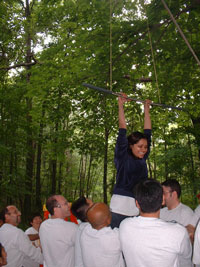Is a Teambuilding or Group-Development Program Right for You?
 Are you considering a Teambuilding program, or a Group-development program? A day to improve the functioning or your group, or a fun-filled retreat from work for the day? The following information will help you determine if you could benefit from Activity-Based Training. By looking carefully at this information and discussing your goals with a specialist from Pack Paddle Ski (PPS), you will be able to determine if your needs and the level of performance and organizational structure of your group are compatible with your desired outcome. Activity Based Training by PPS can be designed to match many of your desired outcomes. There are two general levels of involvement: the Awareness Level and the Group Dynamics Level.
Are you considering a Teambuilding program, or a Group-development program? A day to improve the functioning or your group, or a fun-filled retreat from work for the day? The following information will help you determine if you could benefit from Activity-Based Training. By looking carefully at this information and discussing your goals with a specialist from Pack Paddle Ski (PPS), you will be able to determine if your needs and the level of performance and organizational structure of your group are compatible with your desired outcome. Activity Based Training by PPS can be designed to match many of your desired outcomes. There are two general levels of involvement: the Awareness Level and the Group Dynamics Level.
Awareness Level
PURPOSE: Barrier Breaking
- Facilitates communication by:
- Helping people be more honest
- Helping people communicate at a more significant level
- Giving people practice outside of work
- Providing a structure for communication
- Broadening comfortable communication
- Providing a fun, non-threatening environment
- Reinforcing the importance of communication
- Engages the whole person in interactions (physical, mental, emotional)
- Uses fun to help people interact
- Supports people in a creative, supportive, and healthy interaction through the structure of the day
- Takes place outside of the normal environment which allows for new patterns of interaction
- Gets people better acquainted
- Stimulates the group and looks at the dynamics in the group process as a way of improving group performance
- Celebrates the successes of the group and reinforces the strengths of the group.
- Increases support among the group members
STRUCTURE
- Duration: 4-8 hours
- Location: A comfortable informal setting, preferably with access to outdoor space
- Large-Group Format (6-200 people)
- Instruction Options
- One instructor (Appropriate if the group has a high level of commitment to the purpose)
- One instructor who trains group members to run the activities (Appropriate if the group members need more support to engage in the day)
- One facilitator for each group of 8-15 members (Appropriate for groups interested in the program but have some members with some resistance. Also appropriate for groups who are looking to maximize results of change for the shortest time possible.)
FRONTLOADING PROCESS
- Initial contact
- Complete phone interview. This is to collect basic information about the group's purpose, budget and structure
- Estimate format, purpose and structure
- Decide to proceed or not to proceed
- Create program
- Prepare materials
- Train staff
- Format of training
- Activities
- All activities are fun, challenging and engaging.
- The activities chosen are guided by the group ahead of time based on the desired amount of physical, mental and emotional challenge. Each group will determine their own level of each challenge. The higher the level of challenge the greater the impact.
- Usually the group is presented with a challenge that will require the group to cooperate to create a solution.
- No one is forced to participate. Each person can choose his or her level of physical participation. It is expected each person will do what he or she can to support the group.
- Activities
- Processing
- The material contained in debriefing (usually after each activity) will depend on your purpose. top
Group Dynamics Level
PURPOSE: Includes the purposes of barrier breaking listed in the Awareness Level, as well as these additional areas:
- Communication
- Patterns within the group
- Increasing the level of communication
- Feedback
- Structure of communication within the organization
- Leadership styles
- Empowering others
- Structure within the group
- Setting goals and direction
- Trust
- Problem Solving
- Group efficiency and effectiveness
- Teambuilding
STRUCTURE
- Duration - One day to three days
- Location - From camps to conference centers to wilderness and outdoor locations
- One facilitator/group (max group size 15, optimum 8-12)
FRONTLOADING PROCESS
- Initial Contact
- Phone interview
- Personal interview with client to define goals and discuss appropriateness of training
- Estimate format and budget of program
- Decision to proceed or not proceed
- Get commitment of participants through
- Group members collecting information and persuading others
- Group meeting for consensus to proceed
- Individual interview by facilitator
FORMAT OF THE TRAINING
- Begins by setting goals and objectives
- Set group's expectations of participation and performance
- Activities are used as metaphors for work environment. Designed for specific work structures and goals of training
- Activities are briefed and debriefed as metaphors for work environment
- Discussions are directed into how these activities relate specifically to work
- Goal setting at the end of program on how to carry over the learning to the work environment
- Follow up format is decided upon to reinforce the goals and objectives of the training. top








